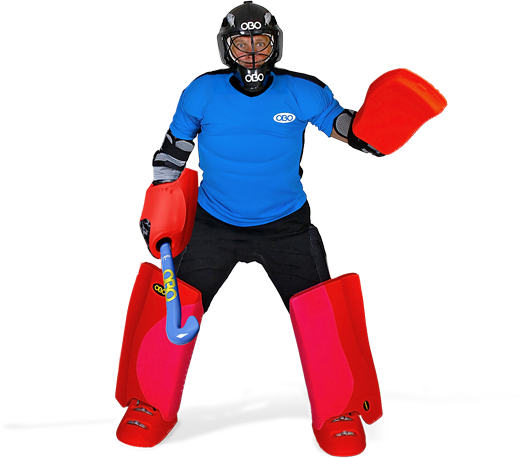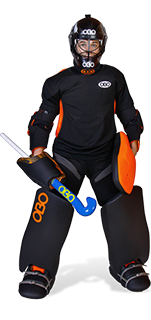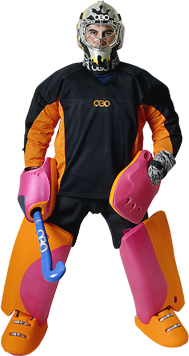KEEPERS RESOURCES

The ‘No goals rules’…
When it comes to goalkeeping, there are a few basic rules when it comes to potentially allowing the goals you do. Not necessarily ones based on technique or style of play, they are focused more on how the goalkeeper allows goals; whether they give away easy goals or if they play as hard to beat. By following these simple and seemingly obvious rules of playing in goal, you can improve your play and challenge shooters to really step up their game to earn their points against you (that is if you give up any goals!).
The rules
Any goal going in against you that breaks the rules laid out, means you aren’t forcing the shooter to beat you. They don’t have to work hard for their goal, as you allow a ‘softie’! All that is happening is you are forcing the shooter to merely put the ball ‘on’ the goal rather than pick a spot that you would be difficult to beat against. A lack of time as the shooter gets a defender coming in to oppose them, is going to make their mind up for them as they simply shoot towards the goal, rather than targeting a specific spot to beat you at. Rather, a shooter ‘working’ the goalkeeper will look to exploit the corners or spots difficult to reach, trying to get around the barrier that is the body in front of them as they shoot. And this is what the goalkeeper wants, to be tested and consequently test their shot stopping abilities!
The following are the rules that cover how you should focus on not giving away easy goals, and will be explored further:
- No goals through you
- No goals above or underneath you
- No poor angle goals
No goals through you
The first rule and most obvious one, is to not concede through you. Not letting a goal go through you and humiliate you is quite important to showing you can get the job down against weaker, less challenging shots. This can be straight through the legs where you struggle to close your legs in time, possibly against a corner or strike from the top of the D, or possibly gaps in your stance, like the holes under your shoulders, with space between gloves and body, against a tip-in for example. This is the same for ice hockey, where goalies are taught to close gaps as they go down to block and play the percentages. In football they really do focus on the adage of never allowing a shot to get through you, teaching the need to get your body behind a shot so that you get as much coverage as possible if you fail on the initial block (wherein they teach technique to bring the chest in to play to help out, as they go to catch a low ball for example).
I couldn’t find a suitable hockey example, so here’s Scott Carson’s mistake against Croatia and reinforces football’s teachings:
http://www.youtube.com/watch?v=GxefXTqeVi4
The following clip does show a hockey example, where at 4:51 playing time, Whitchurch’s Williams unfortunately concedes a squeaker that gets through his legs as it rebounds off the right pad:
http://www.youtube.com/watch?v=SUBtktHtL-k
Or this one where the goalkeeper again unfortunately allows a goal between the legs, against a flick straight down the middle at a short corner:
http://www.youtube.com/watch?v=oYTWzYUkhsM
No goals over or underneath you
Again, just like there should be no goals through you, you should aim to not allow goals squeezed under or over you. Essentially, even though you should work hard not to allow them, shots into the corners are ones that if there are any, are the least embarrassing. Lobbed shots, when you are off your line and beaten by a chipped ball aren’t as regular in hockey as they are in football, but should not be given away so easily against the opposition. And balls squeaking through underneath a kicker not firmly placed on the pitch, or when ‘logging’ against a shot or sliding out to block, should be avoided at all costs. Technique and balancing saves should prevent such occurrences.
Though it’s not necessarily an accurate representation, this video illustrates getting lobbed (not sure how else it would have been stopped as the shooter is in total control of the ball and you can’t tackle on your feet!):
http://www.youtube.com/watch?v=SmZsS2BeI10
No poor angle goals
Just as you should not allow goals through you as a result of poor footwork or a not very efficient ready stance, you should not be giving away easy goals as a result of weak fundamental angle play. Making sure you are on the angle and covering space is essential to any save, but conceding through a poor angle is not great! Allowing a goal inside the gap between you and your near post is considered another no-no. A goal where you concede through the acute angle on year near side is not what you want; if anything, you should be conceding on the other side where you have more work to do to cover more space, rather than your near post which you should be covering properly. A goal allowed on the ‘short side’, like the other goals, is more unforgivable because it shows problems with your fundamentals. Work on your angles and making sure you have them covered, in training and then in games.
In essence, a goal allowed, like this:
http://www.youtube.com/watch?v=IZLW3ardwyc
It’s also possible to get caught out on the short, acute angle as you charge out to challenge the shooter, where you should be making more of an effort to carry on the line of ‘hugging’ the post. A goal like in this clip at 2:56 playing time:
http://www.youtube.com/watch?v=O6nLJt8uaRA
Follow the rules!
Ultimately, it’s a good idea to put these rules to work in your own game. Whilst it’s fun to think about conceding in a different light and making light of goals allowed, these ‘rules’ draw attention to how you should play and what goals you should not be giving up, even if you can make those breath taking stops. Try and focus on them game in game out, so that you give your full attention to being the best shot stopper you are capable of. At the end of the day, make the shooter make the difficult shot, not the easy one!
Comments
Leave Your Comments Below
















































